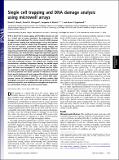| dc.contributor.author | Wood, David | |
| dc.contributor.author | Weingeist, David M. | |
| dc.contributor.author | Bhatia, Sangeeta N. | |
| dc.contributor.author | Engelward, Bevin P. | |
| dc.date.accessioned | 2011-10-03T14:57:02Z | |
| dc.date.available | 2011-10-03T14:57:02Z | |
| dc.date.issued | 2010-06 | |
| dc.date.submitted | 2010-01 | |
| dc.identifier.issn | 1091-6490 | |
| dc.identifier.uri | http://hdl.handle.net/1721.1/66152 | |
| dc.description.abstract | With a direct link to cancer, aging, and heritable diseases as well as a critical role in cancer treatment, the importance of DNA damage is well-established. The intense interest in DNA damage in applications ranging from epidemiology to drug development drives an urgent need for robust, high throughput, and inexpensive tools for objective, quantitative DNA damage analysis. We have developed a simple method for high throughput DNA damage measurements that provides information on multiple lesions and pathways. Our method utilizes single cells captured by gravity into a microwell array with DNA damage revealed morphologically by gel electrophoresis. Spatial encoding enables simultaneous assays of multiple experimental conditions performed in parallel with fully automated analysis. This method also enables novel functionalities, including multiplexed labeling for parallel single cell assays, as well as DNA damage measurement in cell aggregates. We have also developed 24- and 96-well versions, which are applicable to high throughput screening. Using this platform, we have quantified DNA repair capacities of individuals with different genetic backgrounds, and compared the efficacy of potential cancer chemotherapeutics as inhibitors of a critical DNA repair enzyme, human AP endonuclease. This platform enables high throughput assessment of multiple DNA repair pathways and subpathways in parallel, thus enabling new strategies for drug discovery, genotoxicity testing, and environmental health. | en_US |
| dc.description.sponsorship | Massachusetts Institute of Technology. Center for Environmental Health Sciences (Grant NIEHS P30-ES002109) | en_US |
| dc.description.sponsorship | National Institute of Environmental Health Sciences (Genes, Environment, and Health Initiative Grant U01-ES016045) | en_US |
| dc.description.sponsorship | National Institute of Environmental Health Sciences (NIEHS Grant T32-ES07020-34) | en_US |
| dc.language.iso | en_US | |
| dc.publisher | National Academy of Sciences (U.S.) | en_US |
| dc.relation.isversionof | http://dx.doi.org/10.1073/pnas.1004056107 | en_US |
| dc.rights | Article is made available in accordance with the publisher's policy and may be subject to US copyright law. Please refer to the publisher's site for terms of use. | en_US |
| dc.source | PNAS | en_US |
| dc.title | Single cell trapping and DNA damage analysis using microwell arrays | en_US |
| dc.type | Article | en_US |
| dc.identifier.citation | Wood, D. K. et al. “Single cell trapping and DNA damage analysis using microwell arrays.” Proceedings of the National Academy of Sciences 107 (2010): 10008-10013. ©2010 by the National Academy of Sciences. | en_US |
| dc.contributor.department | Harvard University--MIT Division of Health Sciences and Technology | en_US |
| dc.contributor.department | Massachusetts Institute of Technology. Department of Biological Engineering | en_US |
| dc.contributor.department | Massachusetts Institute of Technology. Department of Electrical Engineering and Computer Science | en_US |
| dc.contributor.approver | Engelward, Bevin P. | |
| dc.contributor.mitauthor | Engelward, Bevin P. | |
| dc.contributor.mitauthor | Wood, David | |
| dc.contributor.mitauthor | Weingeist, David M. | |
| dc.contributor.mitauthor | Bhatia, Sangeeta N. | |
| dc.relation.journal | Proceedings of the National Academy of Sciences of the United States of America | en_US |
| dc.eprint.version | Final published version | en_US |
| dc.type.uri | http://purl.org/eprint/type/JournalArticle | en_US |
| eprint.status | http://purl.org/eprint/status/PeerReviewed | en_US |
| dspace.orderedauthors | Wood, D. K.; Weingeist, D. M.; Bhatia, S. N.; Engelward, B. P. | en |
| dc.identifier.orcid | https://orcid.org/0000-0002-1293-2097 | |
| mit.license | PUBLISHER_POLICY | en_US |
| mit.metadata.status | Complete | |
